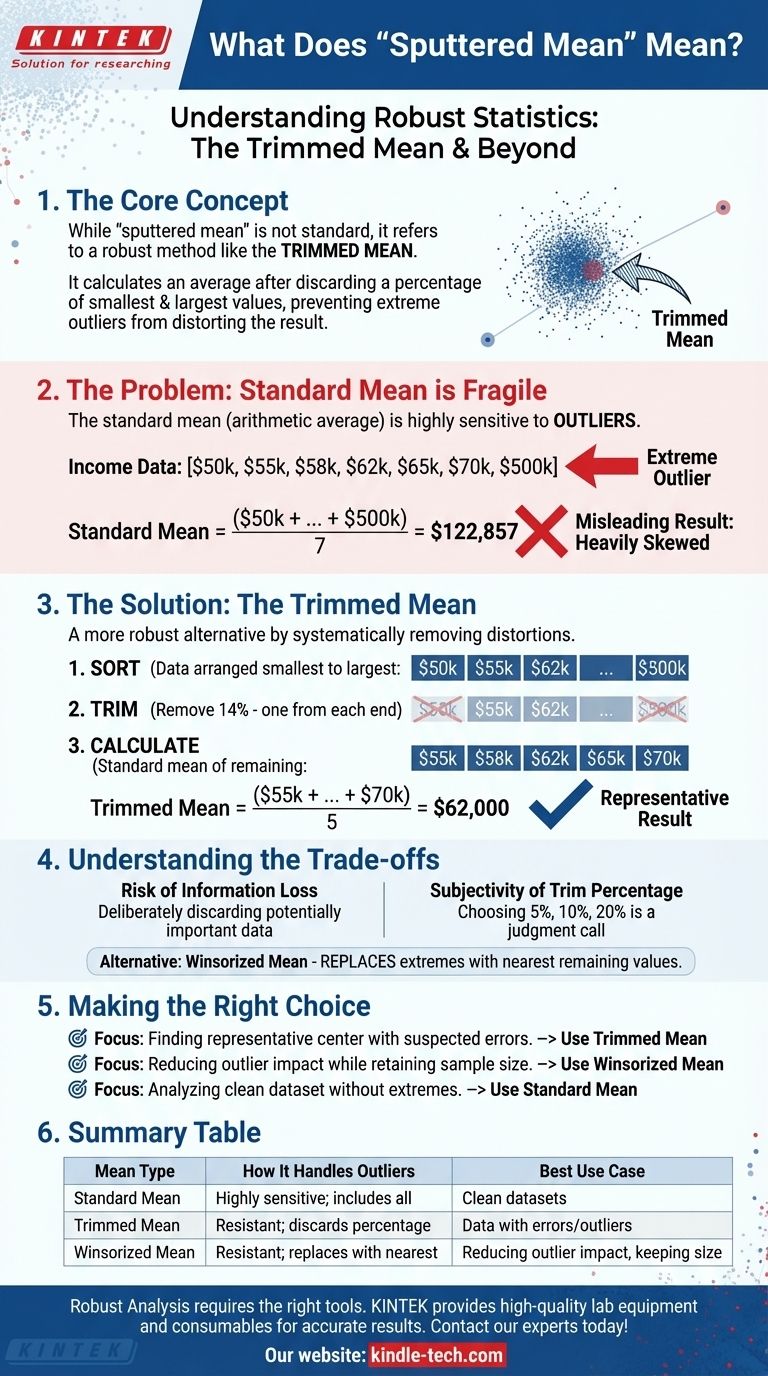Хотя «sputtered mean» не является стандартным статистическим термином, он почти наверняка относится к надежному методу расчета среднего значения, устойчивому к выбросам, скорее всего, к усеченному среднему. Усеченное среднее, также известное как отсеченное среднее, вычисляет среднее значение набора данных после отбрасывания определенного процента наименьших и наибольших значений. Это предотвращает искажение конечного результата экстремальными и, возможно, ошибочными точками данных.
Основная идея усеченного среднего состоит в том, чтобы получить более надежное и репрезентативное среднее значение из «неупорядоченных» данных. Намеренно игнорируя наиболее экстремальные значения с обоих концов, вы вычисляете центральное значение, которое лучше отражает основную массу ваших точек данных.

Проблема: почему стандартное среднее значение хрупко
Стандартное среднее, или арифметическое среднее, является фундаментальным понятием. Однако у него есть один существенный недостаток: оно очень чувствительно к выбросам.
Влияние экстремальных значений
Выброс — это точка данных, которая аномально удалена от других значений в наборе данных. Одно экстремальное значение может значительно сместить стандартное среднее в свою сторону.
Например, рассмотрим сообщенные годовые доходы небольшой команды из семи человек: [$50k, $55k, $58k, $62k, $65k, $70k, $500k].
Стандартное среднее составляет $122,857. Это число неточно представляет ни одного человека в команде и сильно искажено одним высокооплачиваемым сотрудником.
Решение: усеченное среднее
Усеченное среднее предлагает более надежную альтернативу, систематически устраняя эти искажения.
Как работает усеченное среднее
Процесс прост:
- Отсортируйте данные от наименьшего к наибольшему.
- Отсеките небольшой, заранее определенный процент значений как сверху, так и снизу отсортированного списка.
- Вычислите стандартное среднее оставшихся данных.
Предыдущий пример, пересмотренный
Используя наши данные о доходах и применяя 14%-ную обрезку (что соответствует удалению одного значения с каждого конца нашего списка из семи точек), мы сначала удаляем $50k и $500k.
Оставшиеся значения: [$55k, $58k, $62k, $65k, $70k].
Новое усеченное среднее составляет $62,000. Эта цифра является гораздо более реалистичной и репрезентативной мерой типичного дохода команды.
Понимание компромиссов
Использование усеченного среднего — мощный метод, но это не универсальное решение. Оно предполагает принятие обоснованного решения, которое сопряжено с компромиссами.
Риск потери информации
Когда вы обрезаете данные, вы намеренно отбрасываете информацию. Если экстремальные значения, которые вы удаляете, не являются ошибками, а на самом деле являются законными и важными точками данных, вы рискуете исказить свое понимание набора данных.
Субъективность процента обрезки
Выбор того, сколько обрезать (например, 5% против 10% против 20%), является субъективным решением. Не существует единого «правильного» процента, и разные варианты могут привести к разным результатам. Это решение должно основываться на вашем понимании данных и того, почему они могут содержать выбросы.
Когда использовать связанный метод: винзоризованное среднее
Еще одной надежной статистикой является винзоризованное среднее. Вместо удаления экстремальных значений оно заменяет их ближайшими оставшимися значениями. Это позволяет сохранить исходное количество точек данных, при этом уменьшая влияние выбросов.
Правильный выбор для ваших данных
Чтобы решить, какой тип среднего использовать, вы должны сначала уточнить свою аналитическую цель.
- Если ваша основная цель — найти репрезентативный центр для данных с известными или предполагаемыми ошибками: Усеченное среднее — отличный выбор для полного устранения влияния экстремальных выбросов.
- Если ваша основная цель — уменьшить влияние выбросов при сохранении исходного размера выборки: Винзоризованное среднее — более подходящий вариант.
- Если ваша основная цель — анализ чистого, хорошо себя ведущего набора данных без экстремальных выбросов: Стандартное арифметическое среднее остается наиболее прямым и статистически эффективным показателем.
В конечном счете, выбор правильного метода заключается в обеспечении того, чтобы конечное число точно отражало истинную историю, которую рассказывают ваши данные.
Сводная таблица:
| Тип среднего | Как оно обрабатывает выбросы | Лучший вариант использования |
|---|---|---|
| Стандартное среднее | Очень чувствительно; включает все точки данных. | Чистые наборы данных без экстремальных значений. |
| Усеченное среднее | Устойчиво; отбрасывает процент экстремальных значений. | Данные с известными/предполагаемыми ошибками или выбросами. |
| Винзоризованное среднее | Устойчиво; заменяет экстремальные значения ближайшими значениями. | Уменьшение влияния выбросов при сохранении размера выборки. |
Готовы обеспечить надежность и достоверность вашего анализа данных? Правильные статистические инструменты так же важны, как и правильное лабораторное оборудование. В KINTEK мы специализируемся на предоставлении высококачественного лабораторного оборудования и расходных материалов, от которых зависит ваше исследование. Позвольте нам помочь вам создать основу для точных результатов.
Свяжитесь с нашими экспертами сегодня, чтобы обсудить ваши лабораторные потребности!
Визуальное руководство

Связанные товары
Люди также спрашивают
- Что такое метод плазменного спекания? Откройте для себя быстрое производство материалов высокой плотности
- Какова разница между искровым плазменным спеканием и флэш-спеканием? Руководство по передовым методам спекания
- Каков процесс плазменного спекания? Достижение быстрого высокоэффективного уплотнения материалов
- В чем разница между искровым плазменным спеканием и обычным спеканием? Руководство по созданию более быстрых и качественных материалов
- Каков механизм SPS? Разблокировка быстрого низкотемпературного уплотнения
